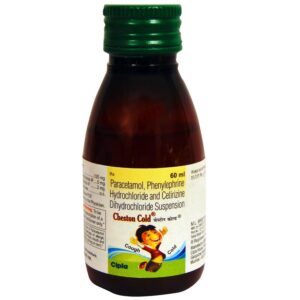CHLORPHENIRAMINE + PARACETAMOL (ACETAMENOPHEN) + BROMHEXINE
Chlorpheniramine: Chlorpheniramine is an antihistamine drug that is commonly used to relieve symptoms associated with allergies, such as sneezing, itching, watery eyes, and runny nose. It is also sometimes used to manage symptoms of the common cold and other respiratory allergies.
The mechanism of action of Chlorpheniramine involves blocking the effects of histamine, a natural substance produced by the body during an allergic reaction. By blocking histamine receptors, Chlorpheniramine helps to reduce or prevent the allergic symptoms caused by histamine release.
Chlorpheniramine is usually taken orally, with or without food. The dose may vary depending on the age, weight, and medical condition of the individual. It is important to follow the recommended dosage provided by a healthcare professional or as mentioned on the medication label.
Common side effects of Chlorpheniramine may include drowsiness, dizziness, dry mouth, blurred vision, constipation, or urinary retention. These side effects are usually mild and temporary but if they persist or worsen, it is advisable to consult a healthcare professional.
Additionally, Chlorpheniramine may cause more severe side effects such as fast/irregular heartbeat, difficulty urinating, mental/mood changes, or seizures. If any of these side effects occur, immediate medical attention should be sought.
It is important to note that Chlorpheniramine may interact with other medications, including sedatives, tranquilizers, and alcohol, leading to increased drowsiness. It is advisable to inform a healthcare professional about all the medications being taken to avoid any potential drug interactions.
Overall, Chlorpheniramine is an antihistamine medication used to relieve allergy symptoms. It works by blocking histamine receptors, and its common side effects include drowsiness, dizziness, dry mouth, and blurred vision.
Paracetamol (acetamenophen): Paracetamol, also known as acetaminophen, is a commonly used over-the-counter medication for pain relief and fever reduction. It is part of a class of drugs called analgesics and antipyretics.
Paracetamol works by blocking the production of prostaglandins in the brain, which are chemicals that cause pain and fever. It is believed to work primarily in the central nervous system to reduce pain and lower body temperature.
This drug is used to alleviate mild to moderate pain, such as headaches, toothaches, muscle aches, and menstrual cramps. It is also effective in reducing fever associated with common colds and flu.
The usual adult dose of paracetamol is 500 to 1000 mg every 4 to 6 hours, up to a maximum of 4000 mg (4 grams) per day. It is important to follow the recommended dosage and not exceed the maximum daily limit to avoid potential liver damage.
While paracetamol is generally considered safe when used as directed, it can have side effects in some individuals. Common side effects include nausea, vomiting, stomach pain, and rash. In rare cases, it can cause serious allergic reactions, liver damage, or blood disorders.
It is important to note that paracetamol can interact with other medications, such as blood thinners, certain antibiotics, and other pain relievers. It is advisable to consult a healthcare professional before taking paracetamol if you are taking other medications or have any underlying medical conditions.
Overall, paracetamol is a widely used and effective medication for pain relief and fever reduction. However, it is essential to follow dosage instructions and be aware of potential side effects to use it safely and effectively.
Bromhexine: Bromhexine is a medication primarily used in the treatment of respiratory conditions, specifically in the management of respiratory disorders accompanied by excessive or thickened mucus secretion. It belongs to a class of drugs called mucolytics.
The primary use of Bromhexine is to alleviate symptoms of respiratory conditions such as bronchitis, chronic obstructive pulmonary disease (COPD), and asthma. It works by breaking down and thinning the mucus in the respiratory tract, making it easier to cough up and clear the airways. This can help relieve coughing and congestion, and facilitate breathing.
Bromhexine is typically taken orally in the form of tablets or syrup. The usual recommended dose for adults is 8-16 mg, three times daily. For children, the dose is adjusted based on their age and weight. It is important to follow the prescribed dosage and instructions provided by a healthcare professional.
As with any medication, Bromhexine has potential side effects that may occur in some individuals. These side effects can include gastrointestinal disturbances such as nausea, vomiting, and stomach discomfort. These symptoms are usually mild and transient. Rarely, allergic reactions may occur, and if any severe side effects are experienced, medical attention should be sought immediately.
It is crucial to note that Bromhexine should be used with caution in patients with a history of gastric or duodenal ulcers, as well as in patients with impaired hepatic (liver) or renal (kidney) function. Pregnant or breastfeeding women should also consult with their healthcare provider before using this medication.
In summary, Bromhexine is a mucolytic medication used to manage respiratory conditions by breaking down and thinning mucus, making it easier to clear the airways. It is available in the form of tablets or syrup, with the dosage depending on the age and weight of the patient. While generally well-tolerated, Bromhexine may cause mild gastrointestinal side effects, and caution should be exercised in patients with certain medical conditions.

